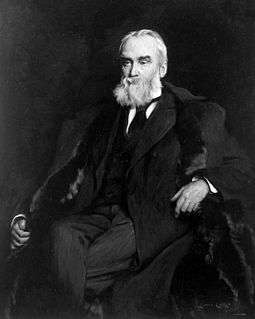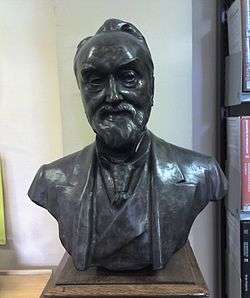John Hughlings Jackson
| John Hughlings Jackson | |
|---|---|
|
Bust of John Hughlings Jackson, resident in the Institute of Neurology, London | |
| Born |
4 April 1835 Providence Green, Green Hammerton, Yorkshire |
| Died |
7 October 1911 (aged 76) London |
| Nationality | English |
| Fields | Neurology |
John Hughlings Jackson, FRS (4 April 1835 – 7 October 1911) was an English neurologist. He is best known for his research on epilepsy.
Biography
He was born at Providence Green, Green Hammerton, near Harrogate, Yorkshire, the youngest son of Samuel Jackson, a brewer and yeoman who owned and farmed his land, and Sarah Jackson (née Hughlings), the daughter of a Welsh revenue collector. His mother died just over a year after giving birth to him. He had three brothers and a sister; his brothers emigrated to New Zealand and his sister married a physician.[1] He was educated at Tadcaster, Yorkshire and Nailsworth, Gloucestershire before attending the York Medical and Surgical School. After qualifying at St Barts in 1856 he became house physician to the York Dispensary.
In 1859 he returned to London to work at the Metropolitan Free Hospital and the London Hospital. In 1862 he was appointed Assistant Physician, later (1869) full Physician at the National Hospital for Paralysis and Epilepsy located in Queen Square, London (now the National Hospital for Neurology and Neurosurgery) as well as Physician (1874) at the London Hospital. During this period he established his reputation as a neurologist. He was elected a Fellow of the Royal Society in 1878.
Jackson died in London on 7 October 1911 and was buried in Highgate cemetery. He was an atheist. [2][3] The Hull York Medical School building at the University of York is named in his honour.
Science and research

Jackson was an innovative thinker and a prolific and lucid, if sometimes repetitive, writer. Though his range of interests was wide, he is best remembered for his seminal contributions to the diagnosis and understanding of epilepsy in all its forms and complexities.[4][5] His name is attached eponymously to the characteristic "march" (The Jacksonian March) of symptoms in focal motor seizures [6] and to the so-called "dreamy state" of psychomotor seizures of temporal lobe origin.[7] His papers on the latter variety of epilepsy have seldom been bettered in their descriptive clinical detail or in their analysis of the relationship of psychomotor epilepsy to various patterns of pathological automatism and other mental and behavioural disorders.
Jackson also did research on aphasia, noting that some aphasic children were able to sing, even though they had lost the power of ordinary speech.[8][9]
In his youth Jackson had been interested in conceptual issues and it is believed that in 1859 he contemplated the idea of abandoning medicine for philosophy.[10] Thus, an important part of his work concerned the evolutionary organization of the nervous system for which he proposed three levels: a lower, a middle,[11] and a higher. At the lowest level, movements were to be represented in their least complex form; such centres lie in the medulla and spinal cord. The middle level consists of the so-called motor area of the cortex, and the highest motor levels are found in the prefrontal area.
The higher centres inhibited the lower ones and hence lesions thereat caused ‘negative’ symptoms (due to an absence of function). ‘Positive’ symptoms were caused by the functional release of the lower centres. This process Jackson called ‘dissolution’, a term he borrowed from Herbert Spencer.[12] The ‘positive-negative’ distinction he took from Sir John Reynolds.[13]
Continental psychiatrists and psychologists (e.g. Ribot, Janet, Freud, Ey) have been more influenced by Jackson’s theoretical ideas than their British counterparts.[14] During the 1980s, the ‘positive-negative’ distinction was introduced in relation to the symptoms of schizophrenia.[15]
He was one of only a few physicians to have delivered the Goulstonian (1869), Croonian (1884) and Lumleian (1890) lectures to the Royal College of Physicians [16] He also delivered the 1872 Hunterian Oration to the Hunterian Society.
Methodology
Jackson could not use modern sophisticated neuro-investigative technology (it had not been invented), but had to rely upon his own powers of clinical observation, deductive logic and autopsy data.[17] Some of his eminent successors in the field of British neurology have been critical of many of his theories and concepts; but as Sir Francis Walshe remarked of his work in 1943, " ... when all that is obsolete or irrelevant is discarded there remains a rich treasure of physiological insight we cannot afford to ignore."
In Otfrid Foerster's research on the motor cortex, he cites exclusively Hughlings Jackson for the initial discovery (although without evidence) of the brain as the spring of neurological motor signalling.[18]
Contributions
Together with his friends Sir David Ferrier and Sir James Crichton-Browne, two eminent neuropsychiatrists of his time, Jackson was one of the founders of the important Brain journal, which was dedicated to the interaction between experimental and clinical neurology (still being published today). Its inaugural issue was published in 1878.
In 1892, Jackson was one of the founding members of the National Society for the Employment of Epileptics (now the National Society for Epilepsy), along with Sir William Gowers and Sir David Ferrier.
Oliver Sacks repeatedly cited Jackson as an inspiration in his neurologic work.
References
- ↑ Critchley, Macdonald; Critchley, Eileen A. (1998). John Hughlings Jackson : Father of English Neurology (PDF). Oxford University Press. pp. 7–8. Retrieved 17 May 2013.
- ↑ http://www.nndb.com/people/020/000204405/
- ↑ Siegman, Aron Wolfe., and Stanley Feldstein. Nonverbal Behavior and Communication. Hillsdale, NJ: L. Erlbaum Associates, 1978. Print.
- ↑ Srp Arh Celok Lek. "Dr. John Hughlings Jackson". US National Library of Medicine. Retrieved 11 October 2013.
- ↑ Balcells Riba, M (1999). "[Contribution of John Hughlings Jackson to the understanding of epilepsy].". Neurología. 14 (1): 23–28. PMID 10079688. Lay summary.
He systematized what we today know as complex partial crisis, establishing the link between the function of the temporal lobe and the sensorial auras, automatism's, déjà-vu and jamais vu phenomena.
- ↑ York, George K; Steinberg, David A (2011). "Hughlings Jackson's neurological ideas.". Brain : a journal of neurology. 134 (Pt 10): 3106–3113. doi:10.1093/brain/awr219. Lay summary.
By observing the march of epileptic seizures he developed the idea of somatotopic representation.
- ↑ Lardreau, Esther (2011). "An approach to nineteenth-century medical lexicon: the term "dreamy state".". Journal of the history of the neurosciences. 20 (1): 34–41. doi:10.1080/09647041003740937. Lay summary.
Hughlings-Jackson coined the concept of dreamy state: According to him, one of the sensations of a "dreamy state" was an odd feeling of recognition and familiarity, often called "deja vu". A clear sense of strangeness could also be experienced in the "dreamy state" ("jamais vu").
- ↑ Johnson, Julene K; Graziano, Amy B (2015). "Some early cases of aphasia and the capacity to sing.". Progress in brain research. 216: 73–89. Lay summary.
The observation that some patients with aphasia and limited speech output were able to sing the texts of songs inspired scholars to examine the relationship between music and language. Early ideas about the capacity to sing were provided by well-known neurologists, such as John Hughlings Jackson and Adolf Kussmaul.
- ↑ Lorch, Marjorie Perlman; Greenblatt, Samuel H (2015). "Singing by speechless (aphasic) children: Victorian medical observations.". Progress in brain research. 216: 53–72. doi:10.1016/bs.pbr.2014.11.003. PMID 25684285. Lay summary.
One notable publication was of two cases of children briefly observed by John Hughlings Jackson (1835-1911) in 1871. These children were speechless but could produce some musical expression.
- ↑ James Taylor, ‘Jackson, John Hughlings (1835–1911)’, rev. Walton of Detchant, Oxford Dictionary of National Biography, Oxford University Press, 2004
- ↑ Phillips, C G (1973). "Proceedings: Hughlings Jackson Lecture. Cortical localization and "sensori motor processes" at the "middle level" in primates.". Proceedings of the Royal Society of Medicine. 66 (10): 987–1002. PMID 4202444.
- ↑ Berrios, G. E. (2001). "The factors of insanities: J. Hughlings Jackson. Classic Text No. 47". History of Psychiatry. 12 (47 Pt 3): 353–73. doi:10.1177/0957154x0101204705. PMID 11954572.
- ↑ Berrios, G. E. (1985). "Positive and negative symptoms and Jackson. A conceptual history". Archives of General Psychiatry. 42 (1): 95–7. doi:10.1001/archpsyc.1985.01790240097011. PMID 3881095.
- ↑ Berrios G E (1977) Henri Ey, Jackson et les idées obsédantes. L'Evolution Psychiatrique 42: 685–699
- ↑ Berrios, G. E. (1991). "Positive and Negative Signals: A Conceptual History". Negative Versus Positive Schizophrenia. p. 8. doi:10.1007/978-3-642-76841-5_2. ISBN 978-3-642-76843-9.
- ↑ Hughesnet Internet | Satellite Internet Deals | 1-855-267-3692. Novoseek.com. Retrieved on 29 May 2014.
- ↑ Eadie, MJ (1990). "The evolution of J. Hughlings Jackson's thought on epilepsy". Clinical and Experimental Neurology. 27: 29–41. Lay summary.
By 1870, and within 5 or 6 years of his beginning to analyse the clinical phenomena of epilepsy and to correlate them with autopsy data, the 35-year-old John Hughlings Jackson had come to a view of the nature of epilepsy that was radically different from that of his contemporaries
- ↑ Foerster, O. (1936). "The Motor Cortex in Man in the Light of Hughlings Jackson's Doctrines". Brain. 59 (2): 135–159. doi:10.1093/brain/59.2.135.
External links
| Wikimedia Commons has media related to John Hughlings Jackson. |
| Wikisource has original works written by or about: John Hughlings Jackson |
- Biography
- 100 Years of Brain Journal
- John Jackson on Find-A-Grave
- Photo from Encyclopædia Britannica.
- Hughlings Jackson's documents in the Queen Square Archive
